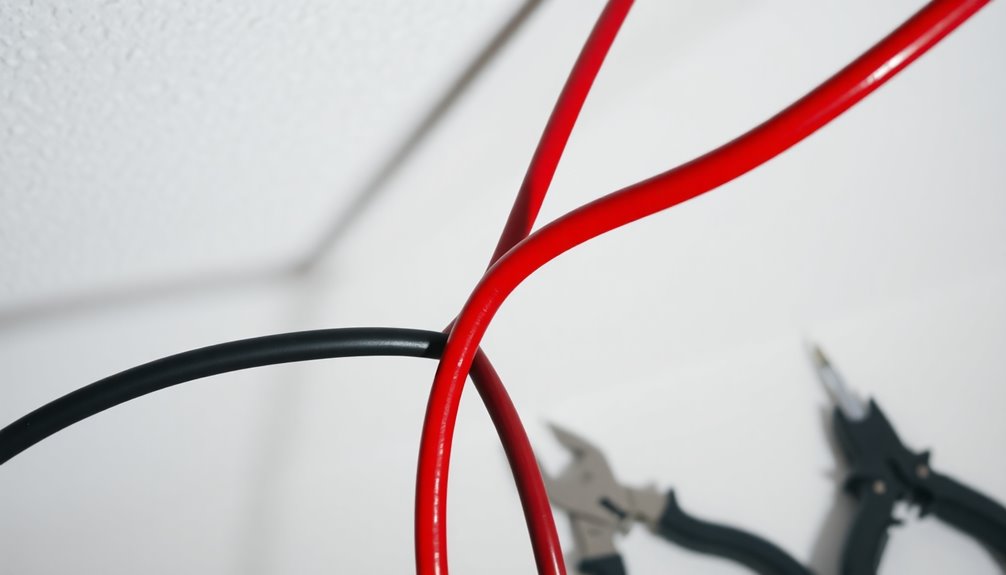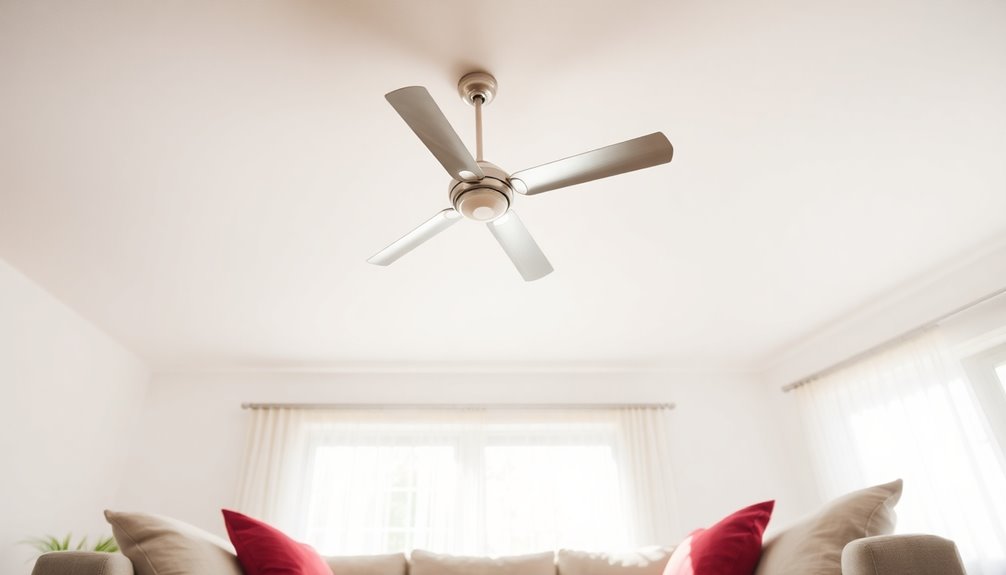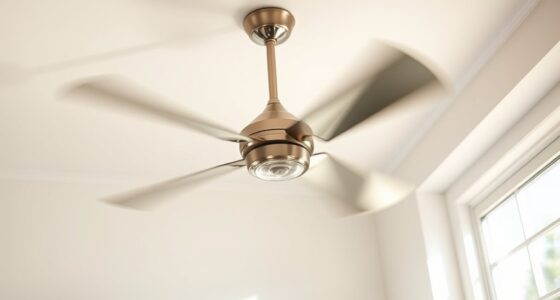You shouldn't connect red and black wires together in a ceiling fan installation. The black wire typically serves as the power supply for the fan, while the red wire often controls additional components like a light kit. Mixing these wires can cause circuit overloads, overheating, or even fires. To guarantee safety, cap the unused red wire if you're not using a light fixture and follow all local electrical codes. It's always wise to consult the manufacturer's instructions or a licensed electrician for complex setups. Stick around to uncover more about proper wiring practices and common installations.
Key Takeaways
- Connecting red and black wires together can cause circuit overload or electrical hazards, potentially leading to overheating or fires.
- The black wire is typically the hot wire, while the red wire may control a light kit, requiring careful handling.
- If both black and red wires are present, cap the red wire to ensure safe operation and avoid misconfigurations.
- Always follow manufacturer instructions and local electrical codes to ensure compliance and safety during installation.
- Consult a licensed electrician for complex wiring setups to prevent mistakes and ensure proper connections.
Understanding Wiring Basics
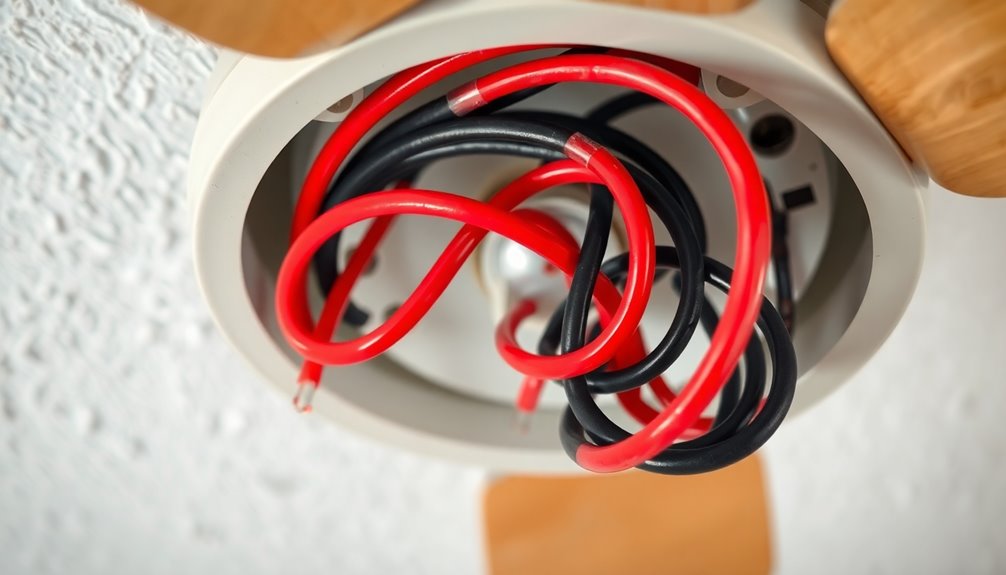
Understanding the basics of wiring is essential when installing a ceiling fan. You'll typically encounter three wire colors: black, red, and white. The black wire usually serves as the hot wire, supplying power to the fan. The white wire acts as the neutral wire, completing the circuit for the fan's operation.
If your ceiling wiring includes a red wire, it often serves as a secondary control, perhaps for a light kit. When you're ready to connect the fan, verify you identify the wire colors correctly. Connect the black wire coming from the electrical box to the fan motor. This connection powers the fan.
If you have red and black wires, be cautious—connecting them together can lead to issues if they're meant for different functions. Always refer to local electrical codes to verify your installation is safe and compliant.
Double-checking your connections can save you from potential hazards down the line. Proper fan wiring involves understanding the purpose of each wire and following the guidelines to power the fan effectively and safely.
Risks of Connecting Wires
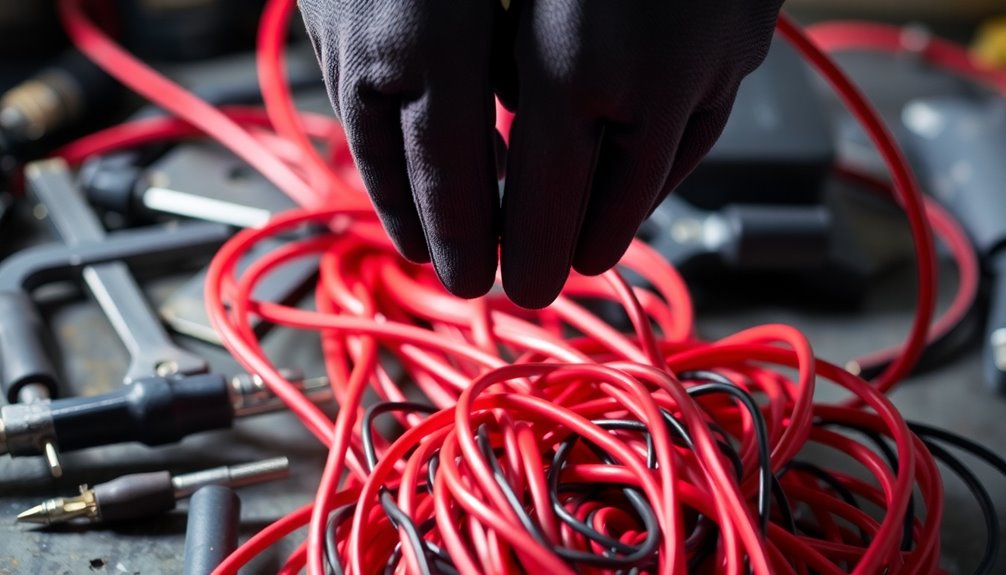
When connecting wires for your ceiling fan, you need to be aware of the risks involved.
Mixing hot wires can lead to circuit overload, which might trip breakers or cause serious damage to your home's wiring.
Plus, ignoring electrical codes can put you at risk for legal issues and safety violations, so it's essential to follow proper guidelines.
Circuit Overload Potential
Circuit overloads can pose serious risks when connecting wires in a ceiling fan setup. If you connect red and black wires together without proper configuration, you might inadvertently create a circuit overload. This can happen when both wires provide power to different functions like the fan and light, leading to potential electrical hazards.
When you connect multiple hot wires incorrectly, it can exceed the rated current capacity of your circuit, increasing the risk of overheating and even fire. Electrical codes typically prohibit connecting two hot wires unless they're designed for that purpose, as this can lead to significant safety issues.
The potential for short circuits also rises when wires not meant to be joined are connected. This can cause tripped breakers or blown fuses, leaving your system vulnerable.
To prevent these issues, it's essential to guarantee any wiring modifications maintain the integrity of the circuit. Seeking a professional evaluation can provide you with the necessary guidance and help you safely navigate your ceiling fan installation, avoiding the dangers of circuit overloads and guaranteeing compliance with electrical codes.
Code Violation Risks
Connecting wires in a ceiling fan can easily lead to code violations if you're not careful. When you combine black and red wires, you risk failing to comply with local electrical codes. These codes often require that separate circuits be maintained for different functions, like the fan and light. Ignoring this rule can cause circuit overloads, which may lead to overheating and serious fire hazards.
If both wires are meant to control different components, connecting them together can result in malfunction or damage to your ceiling fan and its electrical components. This couldn't only create safety issues but also result in costly repairs.
To guarantee you're adhering to safety standards, it's essential to consult local electrical codes and consider hiring a licensed electrician. They can help you navigate the complexities of wiring and guarantee that your setup is both safe and compliant.
Wiring Configurations Explained

When wiring your ceiling fan, it's essential to understand each wire's function to guarantee safe operation.
You'll want to familiarize yourself with safe wiring practices and the different switch control options available.
This knowledge will help you avoid potential hazards and achieve effective fan performance.
Understanding Wire Functions
Understanding wire functions is important for safely wiring a ceiling fan. In most setups, the black wire acts as the hot wire, supplying power to the fan motor. Meanwhile, the red wire typically serves as a secondary hot wire, often designated for a light kit or another function. This configuration allows for independent control of the fan and light, which is a convenient feature.
It's essential to recognize that connecting the black wire and red wire together can create a direct short circuit. This situation poses significant electrical hazards, especially if the wiring isn't designed for such connections.
In a standard installation, the black wire should connect to the fan motor, while the red wire connects to the light kit if your ceiling fan includes one.
Always remember that proper identification of wire functions is important. The black wire is primarily used for the main power supply, whereas the red wire may be utilized for a separate switch or function.
To guarantee safety and compliance with electrical codes, consult the manufacturer's instructions or a licensed electrician before making any connections.
Safe Wiring Practices
Identifying wire functions lays the groundwork for safe wiring practices in ceiling fan installations. Understanding that black wires typically serve as hot wires from the power source, while red wires may control additional functions, is essential.
Connecting red and black wires together without confirming their roles can create a short circuit and lead to potential electrical hazards. To guarantee safe connections, you need to identify the function of each wire properly.
Proper labeling and documentation of existing wiring configurations are imperative. This practice not only helps you avoid confusion but also minimizes the risk of code violations in future modifications.
When working with multiple hot wires, the complexity increases, making it important to consult a licensed electrician. They can provide guidance to ensure compliance with safety standards and local electrical codes.
Switch Control Options
Switch control options for ceiling fans can considerably enhance your comfort and convenience. Understanding how to configure the wiring is key to effectively controlling your fan and light.
In a typical setup, the black wire powers the fan, while the red wire can control a separate light fixture. Here are some common switch control configurations:
- Single Switch: Connect the black wire to control both the fan and light together.
- Dual Switch: Connect the black wire to one switch for the fan, and the red wire to another switch for the light.
- Remote Control: Use a remote to control both the fan and light, eliminating the need for wall switches.
- Smart Switch: Install a smart switch that allows you to control the fan and light via an app or voice command.
Be cautious when connecting wires. Directly connecting the red and black wires can lead to circuit overload or improper operation.
Always follow manufacturer instructions and local electrical codes to guarantee safe wiring for your ceiling fan. Knowing how to control your fan and light separately can greatly improve your home's ambiance.
Tools and Safety Measures

When working on your ceiling fan installation, having the right tools and safety measures in place is essential. Start by gathering insulated tools to protect yourself from electrical shock while handling wires. A voltage tester is a must-have; it allows you to verify that all wires aren't live before you begin your work.
Safety gear is also critical. Wearing rubber gloves and safety glasses can protect you from electrical hazards and any accidental injuries that may occur while you're working.
As you make your wire connections, make certain they're tight and secure. Loose connections can lead to overheating, which poses a risk of electrical fires and damage to your fan or wiring.
Finally, familiarize yourself with local electrical codes and regulations. This knowledge makes certain that your installation complies with safety standards, giving you peace of mind.
Common Ceiling Fan Components

A ceiling fan consists of several essential components that work together to provide comfort and functionality. Understanding these parts can help you with installation and maintenance while ensuring electrical safety.
Key components include:
- Motor: The heart of the ceiling fan, driving the blades to circulate air.
- Blades: These create airflow, and their design impacts efficiency and aesthetics.
- Mounting bracket: This secures the fan to the ceiling and supports its weight.
- Wiring: Essential for connecting the fan to the power supply and controls.
Typically, the black wire is the hot wire, linking to the fan's power supply, while the white wire serves as the neutral wire. If your fan has a light kit, it may connect to a separate red wire, allowing for independent lighting control.
The ground wire, which is usually green or bare copper, plays a critical role in electrical safety by preventing shocks.
Fan control options can vary, with some fans featuring pull chains or remote controls to adjust speed settings and lighting. Knowing these components will make your ceiling fan experience much smoother.
Step-by-Step Wiring Process
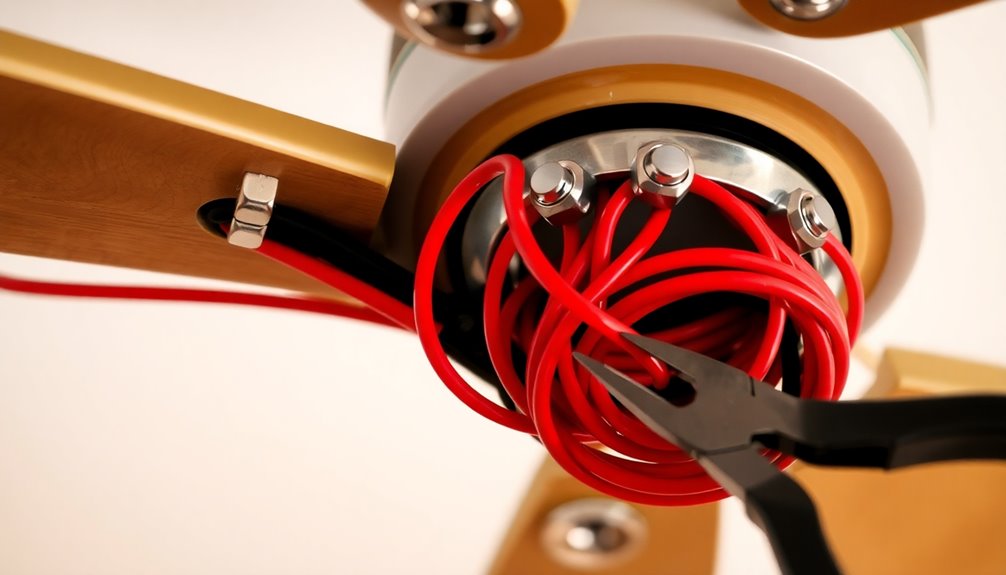
Before you plunge into connecting the wires for your ceiling fan, make sure the power is off at the circuit breaker to keep yourself safe from electrical shock.
Start by identifying the purpose of each wire. The black wire usually serves as the hot wire for the fan motor, while the red wire may control a light kit, if you have one.
Next, grab a multimeter to confirm that the red and black wires are properly assigned. This step is vital to avoid potential short circuits or overloads when connecting them.
Once you've verified the wires, connect the white wire (neutral) to its corresponding white wire in the ceiling. Then, connect the ground wire, which is usually bare or green, to the ground wire in the ceiling.
If you're unsure about the wiring configuration, it's best to consult a professional electrician. Proper connections are essential for safe operation and compliance with electrical codes.
Double-check all connections before turning the power back on, ensuring everything is securely in place. By following these steps, you can successfully wire your ceiling fan without issues.
Expert Recommendations
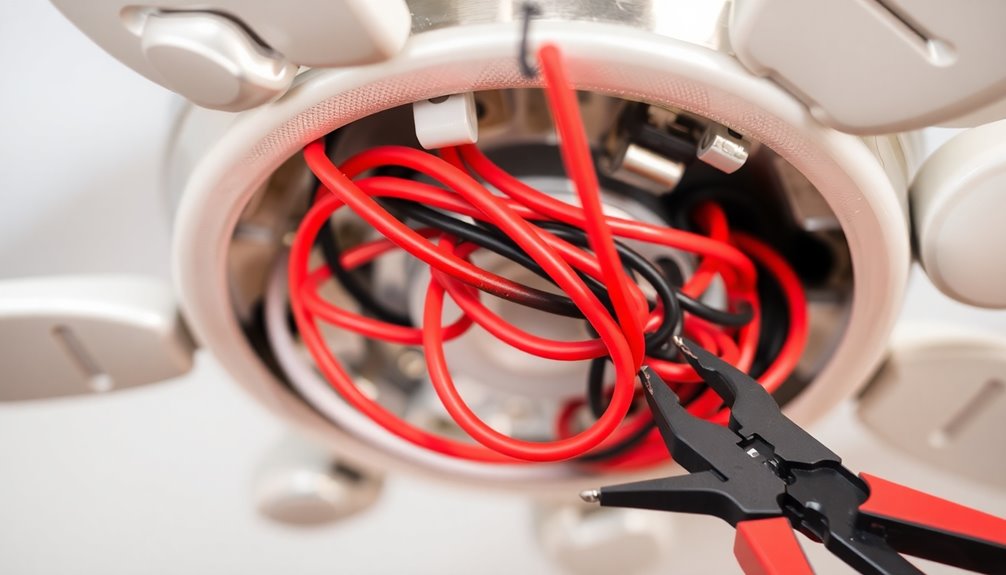
To guarantee a safe and effective ceiling fan installation, experts emphasize the importance of proper wire identification and connection. Connecting the red and black wires together can lead to potential short circuits, electrical overloads, and violations of electrical codes.
Here's what you should keep in mind:
- The black wire typically serves as the hot wire, while the red wire may control additional functionalities, like a light kit.
- If both wires are hot, it's best to cap one to secure safe operation and avoid confusion in future adjustments.
- Always follow the manufacturer instructions and wiring diagrams specific to your ceiling fan model for accurate connections.
- When in doubt about wiring configurations, consulting a licensed electrician is advisable. They can clarify any uncertainties and guarantee compliance with electrical codes.
Community Insights

Community feedback plays an essential role in enhancing the understanding of ceiling fan installations. Many users share their experiences and caution against connecting the black wire and red wire together, as this can lead to serious electrical issues. The black wire typically serves as the hot wire for the fan, while the red wire often controls a light kit or additional features.
To help clarify safe wiring practices, here's a quick overview:
| Wire Color | Function |
|---|---|
| Black | Hot wire for the ceiling fan |
| Red | Usually for light kit control |
| Both together | Risks short circuit or overload |
| Capping | Recommended to prevent confusion |
| Licensed Electrician | Advisable for complex setups |
Community advice often emphasizes the importance of using a wire nut to cap one of the wires when only one switch controls the fan. Improper connections can violate electrical codes and introduce safety risks. To guarantee compliance and safety, consulting a licensed electrician is highly recommended for any complex wiring configurations.
Future Wiring Considerations

Planning for future wiring needs can save you time and trouble down the road. When you're installing a ceiling fan, it's crucial to think about how you might want to modify the setup later.
The red wire, often used for lights, should be capped for future functionality if you aren't using it immediately. This way, you won't face confusion when adding a light kit later.
Here are some best practices for future wiring considerations:
- Labeling unused wires clearly helps prevent confusion during future modifications.
- Documenting changes made during installation is critical for troubleshooting and communicating with electricians if issues arise.
- Regular inspections of your electrical installations can identify potential safety hazards before they escalate.
- Keep the black wire and red wire functions clear in your notes to avoid circuit overload.
Frequently Asked Questions
Can Black and Red Wires Go Together?
When you're working with electrical wires, it's essential to understand their functions.
Black and red wires typically serve different purposes, so connecting them directly isn't advisable. Doing so can create short circuits or even lead to electrical fires.
Always check your wiring diagram and follow local codes. If you're unsure about what to do, it's best to consult a licensed electrician to guarantee your safety and the proper operation of your devices.
Do Red and Black Wires Go Together on a Ceiling Fan?
When you're working with ceiling fan wiring, you might wonder if red and black wires go together.
Generally, the black wire is the hot wire for the fan, while the red wire often controls a light. Connecting them could cause both to operate simultaneously, which might lead to electrical issues.
It's best to test each wire's function first and consider capping the red wire if it's not in use for safety. Always consult a professional if unsure.
How Do You Connect Black and Red Wire to Socket?
Connecting black and red wires to a socket is like piecing together a puzzle; each piece has its rightful spot.
First, verify the power's off at the circuit breaker. Then, connect the black wire to the hot terminal, like placing the corner piece in a jigsaw.
If you don't need the red wire, cap it off securely. Always double-check with a multimeter to avoid any shocking surprises!
Safety's key in this electrical game.
What Does the Red Wire Connect To?
The red wire typically connects to a light kit in your ceiling fan setup, allowing you to control the light independently.
If your fan doesn't have a light kit, you can safely cap off the red wire, indicating it's not in use.
Always check the manufacturer's wiring diagram to determine the correct connection for the red wire, ensuring your setup complies with electrical codes and maintains safety standards.
Don't skip this step!
Conclusion
To sum up, connecting red and black wires together in your ceiling fan isn't just risky—it's like inviting a storm into your living room! The potential for electrical chaos can turn your peaceful home into a shocking disaster zone. So, unless you want sparks flying like fireworks on the Fourth of July, it's best to stick to proper wiring practices. Keep your fan spinning safely and your home cozy, because nobody wants an electrifying surprise!
